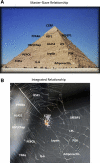Fat circadian biology
- PMID: 19470701
- PMCID: PMC2777788
- DOI: 10.1152/japplphysiol.00090.2009
Fat circadian biology
Abstract
While adipose tissue has long been recognized for its major role in metabolism, it is now appreciated as an endocrine organ. A growing body of literature has emerged that identifies circadian mechanisms as a critical regulator of adipose tissue differentiation, metabolism, and adipokine secretory function in both health and disease. This concise review focuses on recent data from murine and human models that highlights the interplay between the core circadian regulatory proteins and adipose tissue in the context of energy, fat, and glucose metabolism. It will be important to integrate circadian mechanisms and networks into future descriptions of adipose tissue physiology.
Figures


References
-
- Allen C, Kendall JW. Maturation of the circadian rhythm of plasma corticosterone in the rat. Endocrinology 80: 926–930, 1967. - PubMed
-
- Allison KC, Lundgren JD, O'Reardon JP, Martino NS, Sarwer DB, Wadden TA, Crosby RD, Engel SG, Stunkard AJ. The Night Eating Questionnaire (NEQ): psychometric properties of a measure of severity of the Night Eating Syndrome. Eat Behav 9: 62–72, 2008. - PubMed
-
- Ando HUK, Yanagihara H, Hayashi Y, Takamura T, Kaneko S, Fujimuro A. Clock gene expression in the liver, and adipose tissues of non-obese type 2 diabetic Goto-Kakizaki rats. Clin Exp Hypertens 31: 201–207, 2009. - PubMed
-
- Ando H, Yanagihara H, Hayashi Y, Obi Y, Tsuruoka S, Takamura T, Kaneko S, Fujimura A. Rhythmic mRNA expression of Clock genes and adipocytokines in mouse visceral adipose tissue. Endocrinology 146: 5631–5636, 2005. - PubMed
Publication types
MeSH terms
Grants and funding
LinkOut - more resources
Full Text Sources

